Case-study: PREV virus epidemic
With this post I am taking my first step in studying the principles of viral dissemination of information (hands finally reached, cheers). We now talk a lot about the fact that viral advertising is cool, but that it is almost impossible to plan and launch a successful virus in advance. Like, it’s difficult to predict whether the audience will accept the information or not, whether users will distribute it further and blah blah ...
It seems to me that so far no one has seriously bothered studying the principles of the spread of information viruses on the Internet. Therefore, marketers and advertisers have no idea how this is done and what results can be obtained. And those who still bother, keep knowledge in a terrible secret, trying to sell them for big money to transnational corporations.
I decided to start with something simple and strong at the same time - with linguistic viruses, and specifically with the now famous word " Preved ".
*****
To begin with, it makes sense to say a few words, why exactly “Preved”?
Well, firstly, because this word has a clear form, in contrast to other “author’s” expressions - “cross safeg”, for example, it is often written as “Krasafcheg”, “Krosaffcheg” or “handsome”. It is clear, in general, simply “tracking” is easier to track. Secondly, the “preved” seems to me a more independent virus than the other terms of Padonkov’s slang. In short, consider the "Preved".
To be completely honest, we must also say that “preved” has been studied for a long time - almost from the very beginning of the epidemic. For example, a private investigationlinguist German Lukomnikov and an article in the journal "I".
*****
Yandex search on blogs shows that “preved” was mentioned back in 2003 - in three posts . All three posts were published in July 2003 in LiveJournal (for different users).
Further. In 2004, the PNPB has already discovered 14 references , starting in June. All posts are ZhZhshny, written by 8 users, of which:
3 from St. Petersburg,
2 from Kiev,
1 from Moscow,
2 more did not indicate their location.
2005 shows a significant increase in references to “preve”. In 2005, Yandex found 99 posts.. The distribution by months shows a constant (approximately linear) increase in the number of references to “preve” during 2005:
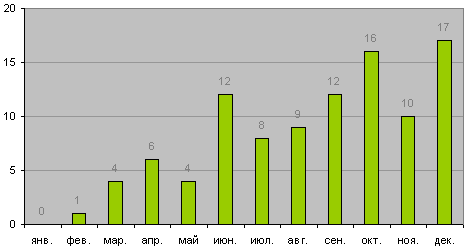
The distribution of posts mentioning “preve” in 2005 (source: Yandex).
The distribution of the sites on which the virus was detected is as follows: The
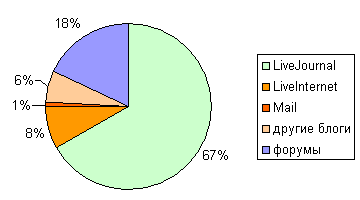
sites where posts with the mention of “preved” were published in 2005 (source: Yandex).
As you can see, in addition to LiveJournal, “preved” appears on other blog hosting sites and in forums, but the main part still remains in LiveJournal. It is worth noting here that among the authors mentioning “preved” in 2005, there are also users who are “infected” earlier in 2004. Most of the posts found are a hell of a mix of Padonkov slang, swearing and banal lytbyber, so after studying this trash I had a headache for a long time, and for several days then I spoke in pure Russian, avoiding any slang :)
*****
2006 year. The fun begins. From the very beginning of the year, the number of infected posts begins to grow quite quickly - in January alone there are about 50(although for the entire previous year there were only twice as many). To more accurately track the time of the beginning of the explosive spread of the virus, we build the distribution of infected posts by week:
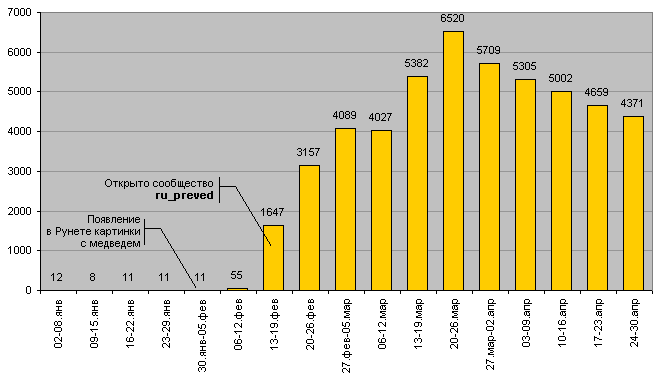
Distribution of posts with the mention of “posts” in January-April 2006 (source: Yandex).
The most interesting here, first of all, are the first three weeks of February, in which something happened that laid the foundation for the explosive spread of the virus. So:
February 3
On Dirty.ru for the first time a picture is published with a bear saying “Preved!”. On the same day, the picture appears in LiveJournal with the user amberaja (not the most popular magazine - now less than one and a half hundred friends).
February 7
LiveJournal user German Lukomnikov ( lukomnikov_1) posts a picture in his LiveJournal and begins to study the emergence and spread of the “preve” on the Runet. Lukomnikov’s magazine is now read by more than a thousand people. In February 2006, of course, there was less, but his post seemed to play an important role in the explosion that followed a week later.
February 12 preved
magazine created . The first post in it, oddly enough, is “TRANSFER!”. From February 16, comments rained down on him.
February 15th ru_preved
community created . The very next day, more than a hundred posts with photojacks on the topic of “preve” appeared in it.
February 17
Registered domain preved.ru, later sold to Rykov for $ 1,500.
It is clear that the main sources of the spread of the virus were e-mail and Internet pagers. However, blogs and forums, as a means of collective communication with memory, contributed steeply to the process of the outbreak of the epidemic.
*****
In parallel, we are building the distribution of news messages containing the word “preved” in online media:
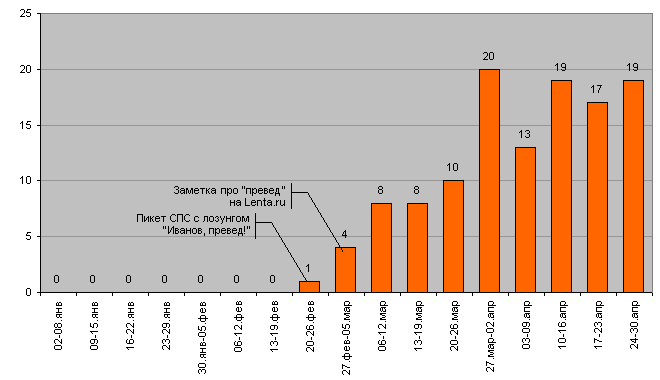
The distribution of news messages with the mention of “preved” in January-April 2006 (source: Yandex).
It is noticeable that the release of the “preve” in the media occurs belatedly in comparison with free blogs and forums. Moreover, the recognition of the “preve” of the media begins after the virus goes offline.
February 23
The activists of the SPS party held a picket near the Main Military Commissariat in Moscow with placards “Fststafku, hellish Soton!” And “Ivanov, great!” On the same day, news of the picket appeared on the ATP website .
On February 28,
Lenta.ru publishes a note on what Preved is.
March 9
A ban on the use of the word “Preved” appears on Dirty.ru. Small online media are actively picking up this news.
Then “preved” goes even more actively offline - large companies begin to use “preved” in their advertising (Sitronics and Contex, in particular, noted), which is immediately reflected in the online press.
Thus, in the first two months after the epidemic began, the media mainly played the role of such popularizers, increasing audience reach and prolonging the effect of the virus.
***** The
peak of the “preve” epidemic occurred in March-April 2006 and, starting in May, the number of references to the “preve” in blogs and forums stopped growing. After this and until now, the PNPB has shown a stable presence of “preve” in blogs and forums.
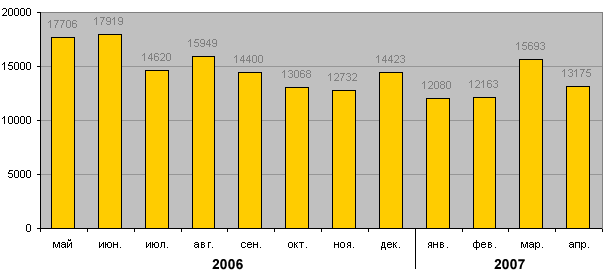
Distribution of posts mentioning “drive” from May 2006 to April 2007 (source: Yandex).
Conclusions
According to the results of the first study, the following assumptions can be made about the mechanics of the spread of information viruses:
0. The history of the virus does not matter. Before the epidemic, “preved” existed for several years and affected only a few dozen people. Several dozens of people can be infected easily in a very short time with very little cost.
1. To start an epidemic , a virus artifact is required (in the case of a “preve” this is the picture), which:
- firstly, reflects the essence of the virus and reveals its meaning,
- secondly, it is an effective carrier of the virus (“preve” picture you can easily post it somewhere, and many people will see it).
2. The explosion itself is due to the rapid infection of a large number of people. Use of opinion-makers is the most suitable for this - the most readable and authoritative blogs (if the popular bloggers hadn’t re-published the “preved” picture, the virus would hardly have worked so powerfully). Publication in the community is not suitable for this purpose, because although every post in the community can have a large audience, the credibility of each individual post is usually low.
3. The essence of the virus should be simple enough to allow the use of the virus by others for their own purposes - both individual Internet users and organizations (including offline).
4. The essence of the virus, or the method of its spread, or its artifact should be quite trendyand perhaps even somewhat provocative, to be able to get into the media, thereby intensifying the epidemic.
Source: Oddboy
It seems to me that so far no one has seriously bothered studying the principles of the spread of information viruses on the Internet. Therefore, marketers and advertisers have no idea how this is done and what results can be obtained. And those who still bother, keep knowledge in a terrible secret, trying to sell them for big money to transnational corporations.
I decided to start with something simple and strong at the same time - with linguistic viruses, and specifically with the now famous word " Preved ".
*****
To begin with, it makes sense to say a few words, why exactly “Preved”?
Well, firstly, because this word has a clear form, in contrast to other “author’s” expressions - “cross safeg”, for example, it is often written as “Krasafcheg”, “Krosaffcheg” or “handsome”. It is clear, in general, simply “tracking” is easier to track. Secondly, the “preved” seems to me a more independent virus than the other terms of Padonkov’s slang. In short, consider the "Preved".
To be completely honest, we must also say that “preved” has been studied for a long time - almost from the very beginning of the epidemic. For example, a private investigationlinguist German Lukomnikov and an article in the journal "I".
*****
Yandex search on blogs shows that “preved” was mentioned back in 2003 - in three posts . All three posts were published in July 2003 in LiveJournal (for different users).
Further. In 2004, the PNPB has already discovered 14 references , starting in June. All posts are ZhZhshny, written by 8 users, of which:
3 from St. Petersburg,
2 from Kiev,
1 from Moscow,
2 more did not indicate their location.
2005 shows a significant increase in references to “preve”. In 2005, Yandex found 99 posts.. The distribution by months shows a constant (approximately linear) increase in the number of references to “preve” during 2005:

The distribution of posts mentioning “preve” in 2005 (source: Yandex).
The distribution of the sites on which the virus was detected is as follows: The

sites where posts with the mention of “preved” were published in 2005 (source: Yandex).
As you can see, in addition to LiveJournal, “preved” appears on other blog hosting sites and in forums, but the main part still remains in LiveJournal. It is worth noting here that among the authors mentioning “preved” in 2005, there are also users who are “infected” earlier in 2004. Most of the posts found are a hell of a mix of Padonkov slang, swearing and banal lytbyber, so after studying this trash I had a headache for a long time, and for several days then I spoke in pure Russian, avoiding any slang :)
*****
2006 year. The fun begins. From the very beginning of the year, the number of infected posts begins to grow quite quickly - in January alone there are about 50(although for the entire previous year there were only twice as many). To more accurately track the time of the beginning of the explosive spread of the virus, we build the distribution of infected posts by week:

Distribution of posts with the mention of “posts” in January-April 2006 (source: Yandex).
The most interesting here, first of all, are the first three weeks of February, in which something happened that laid the foundation for the explosive spread of the virus. So:
February 3
On Dirty.ru for the first time a picture is published with a bear saying “Preved!”. On the same day, the picture appears in LiveJournal with the user amberaja (not the most popular magazine - now less than one and a half hundred friends).
February 7
LiveJournal user German Lukomnikov ( lukomnikov_1) posts a picture in his LiveJournal and begins to study the emergence and spread of the “preve” on the Runet. Lukomnikov’s magazine is now read by more than a thousand people. In February 2006, of course, there was less, but his post seemed to play an important role in the explosion that followed a week later.
February 12 preved
magazine created . The first post in it, oddly enough, is “TRANSFER!”. From February 16, comments rained down on him.
February 15th ru_preved
community created . The very next day, more than a hundred posts with photojacks on the topic of “preve” appeared in it.
February 17
Registered domain preved.ru, later sold to Rykov for $ 1,500.
It is clear that the main sources of the spread of the virus were e-mail and Internet pagers. However, blogs and forums, as a means of collective communication with memory, contributed steeply to the process of the outbreak of the epidemic.
*****
In parallel, we are building the distribution of news messages containing the word “preved” in online media:

The distribution of news messages with the mention of “preved” in January-April 2006 (source: Yandex).
It is noticeable that the release of the “preve” in the media occurs belatedly in comparison with free blogs and forums. Moreover, the recognition of the “preve” of the media begins after the virus goes offline.
February 23
The activists of the SPS party held a picket near the Main Military Commissariat in Moscow with placards “Fststafku, hellish Soton!” And “Ivanov, great!” On the same day, news of the picket appeared on the ATP website .
On February 28,
Lenta.ru publishes a note on what Preved is.
March 9
A ban on the use of the word “Preved” appears on Dirty.ru. Small online media are actively picking up this news.
Then “preved” goes even more actively offline - large companies begin to use “preved” in their advertising (Sitronics and Contex, in particular, noted), which is immediately reflected in the online press.
Thus, in the first two months after the epidemic began, the media mainly played the role of such popularizers, increasing audience reach and prolonging the effect of the virus.
***** The
peak of the “preve” epidemic occurred in March-April 2006 and, starting in May, the number of references to the “preve” in blogs and forums stopped growing. After this and until now, the PNPB has shown a stable presence of “preve” in blogs and forums.

Distribution of posts mentioning “drive” from May 2006 to April 2007 (source: Yandex).
Conclusions
According to the results of the first study, the following assumptions can be made about the mechanics of the spread of information viruses:
0. The history of the virus does not matter. Before the epidemic, “preved” existed for several years and affected only a few dozen people. Several dozens of people can be infected easily in a very short time with very little cost.
1. To start an epidemic , a virus artifact is required (in the case of a “preve” this is the picture), which:
- firstly, reflects the essence of the virus and reveals its meaning,
- secondly, it is an effective carrier of the virus (“preve” picture you can easily post it somewhere, and many people will see it).
2. The explosion itself is due to the rapid infection of a large number of people. Use of opinion-makers is the most suitable for this - the most readable and authoritative blogs (if the popular bloggers hadn’t re-published the “preved” picture, the virus would hardly have worked so powerfully). Publication in the community is not suitable for this purpose, because although every post in the community can have a large audience, the credibility of each individual post is usually low.
3. The essence of the virus should be simple enough to allow the use of the virus by others for their own purposes - both individual Internet users and organizations (including offline).
4. The essence of the virus, or the method of its spread, or its artifact should be quite trendyand perhaps even somewhat provocative, to be able to get into the media, thereby intensifying the epidemic.
Source: Oddboy
